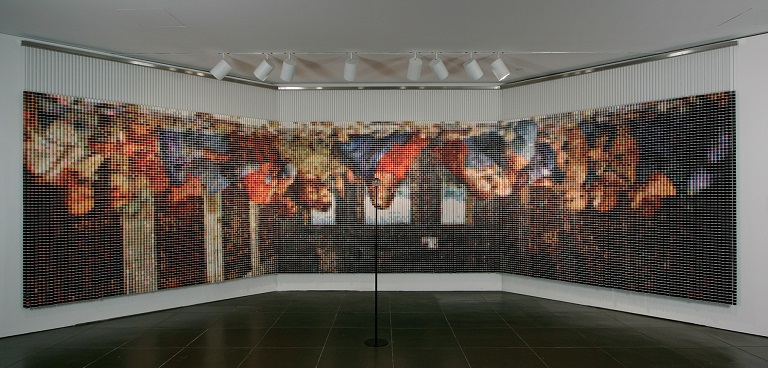“Where is After the Last Supper?”

Devorah Sperber, “After the Last Supper,” 2005
20,736 thread spools, hanging apparatus, ball chain, viewing sphere, and stand
Guests who visited Crystal Bridges in the first few months after our opening in November, 2011, will likely remember the large, dramatic work by Devorah Sperber titled After the Last Supper. The work is a full-scale model of the upper half of Leonardo da Vinci’s famous mural, (minus the bottom of the table and the Apostles’ feet), but instead of paint, the images are created of more than 20,000 spools of colored thread, strung in long rows and hung from the ceiling. Each colored spool acts like a “pixel” in a photographic image: producing a single point of color. Up close, the work looks like a lot of spools of thread… but at a distance the installation reveals itself to be a pixelated—and inverted—image of The Last Supper.
That’s right: the artwork presents the image upside down. It is not until the work is viewed through a clear Plexiglas orb placed in front of the installation that the upright image is revealed. A viewer must be standing directly in front of the viewing orb to see the image correctly: which means that even though the artwork is quite large and clearly visible from a distance to a large number of people, the full experience of the work is actually quite small and highly individual. Only one or at the most two people can properly view the work through the orb at a time.
It is a remarkable work, and one that many of our returning guests remember and comment on. It is, in short, a fan favorite, and we are often asked what happened to it and why it is no longer on view.
After the Last Supper is made of thread, which makes it a textile. Textiles, like other works that are made of “organic” materials such as paper, wood, or leather, are extremely light sensitive. Exposure to light will fade the colors and even damage the structure of these works over time. Obviously, we don’t want any of our artworks to fade. To protect the collection for future generations of guests to enjoy, light-sensitive artworks can only be on view for a limited period of time before they need to return to the darkness of the Museum vaults, where their materials are better protected.
How does light damage art? We are all familiar with the way light fades inks and dyes. Leave a favorite jacket in the back window of your car and you will see the results of light damage in a very short time. What most people may not realize is that light also causes physical wear and tear to the actual fibers of organic materials, gradually weakening and ultimately destroying them. This damage is both cumulative and irreversible, which means that while bright light will quickly fade a watercolor or tapestry, it’s also true that the works will eventually fade just as much if exposed to low light over a longer period of time. Even in a very dimly lit gallery, light-sensitive works are reacting to the light around them.
Artworks can be damaged by visible light: the spectrum of light colors that our eyes perceive. But the worst light offender is a wavelength we can’t see: UV (ultra-violet) light, which is just past our ability to perceive at the blue end of the spectrum.
To understand what is going on with light and damage, we have to get really small and think about artworks on a molecular level. Ultra-violet light is a high-energy light that speeds up the movement of the molecules in the surface of an art work, making them bump against each other more, as well as expand and contract, altering their shape. The eventual result is a change in the way light reflects off of those molecules, which makes it appear different (faded) to our eyes.
To keep this gradual damage as minimal as possible, museums generally restrict the amount of light exposure to which they allow sensitive works to be subjected over the course of a year. After that limit is reached, the works go into darkness for a corresponding period of time before they may be exposed again.
Light is not the only danger to the life of works of art. There are other factors to consider in preserving and protecting the artworks in our collection, including overall ambient temperature and humidity levels. The vaults at Crystal Bridges are usually dark, and are maintained at a constant relative humidity level that minimizes deterioration to the works in our care.
Back to our original question: So when will After the Last Supper return to public view? Weeellll, that’s hard to say. Because the entire Museum will be used to host the upcoming exhibition State of the Art, opening in September, we can say for certain it won’t be until after that exhibition closes: early in 2015 at the earliest. The Sperber is also, obviously, a very large artwork, however, so curators will need to do some serious rearranging of gallery space before it can be put it back on view.
In the meantime, we thought you might enjoy viewing this cool time-lapse video of the initial installation of After the Last Supper, back in 2011. This video, and others similar to it, are available all the time on Crystal Bridges’ iTunes U site!




